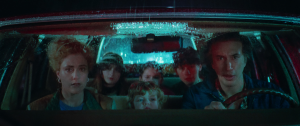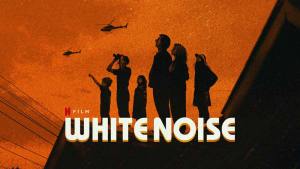Trois Ono
Films based on books often fail to reach the hype upon release and lack crucial details in order to fit in the running time. An example is The Giver which received a 35% on Rotten Tomatoes. Weirdly enough, White Noise, directed by Noam Baumbach, fails to reach the depth of the novel written by Don DeLillo because of the opposite; Baumbach tries to create a film that completely encapsulates the novel.

Set in the 1980s, highlighting consumerism, the rise of technology, and death, White Noise focuses on Jack Gladney, portrayed by Adam Driver, an academic at the College-on-the-hill who creates his own field entirely focused on the life of Nazi dictator, Hitler. He and his family are forced to evacuate their neighborhood after a train crash releases toxic chemicals into the Ohio winds. Unfortunately, Jack is exposed to chemical waste and his death anxiety increases. On the other hand, Babette, his wife played by Greta Gerwig, is extremely distant towards the family after the chaos and becomes more forgetful.
What pulled me to watch this film was the amazing cast. Adam Driver, known for his exceptional performance in Marriage Story (also directed by Baumbach) works with Greta Gerwig, who will release the highly anticipated movie she directed, Barbie, later this year. The acting did not disappoint but at times, I felt that there was a lack of chemistry between the couple. Although I also wonder if that was the point. Another A-list actor, Don Cheadle, plays the friend and academic rival Professor Murray Siskind. Unfortunately, the relationship between Jack and Murray wasn’t developed enough. Their two-sided relationship could’ve had more intense moments than just the classroom battle of intellect.
Throughout the film, we see how death anxiety affects the lives of civilians. What is interesting, however, is that they feed their thanatophobia by constantly watching catastrophic accidents on television. Although it seems completely absurd, DeLillo speaks the truth in this thorny question of society. We are always drawn to the deaths of others, not always grieving the lives lost and instead being ever so grateful that it wasn’t us in their place.
Jack does exactly this and strongly believes that he doesn’t fit the “role” of the dead in the crashes seen on TV. We see him struggle with mortality when he finds out that pumping gas in his car was enough exposure for him to see the side effects of the toxic fumes. In comparison to Babette, there were many opportunities to explore how he struggled in a way that was more unique and discreet.
The cinematography of this film was great and I especially enjoyed the crash zooms, often used in horror or action films, because it added on to the extra movement symbolic of the fast-pace the world was adapting to. Filmed on 35mm film, the movie itself was visually pleasing thanks to the colour grading, harsh contrast, and visual effects which reminded me of a few scenes from Stranger Things and Taxi Driver. The setting of the scenes, especially the supermarket where all rows were neatly and completely filled with products, enhanced the uncanny feeling of the world in the film.
All in all, White Noise is a waste of an IB student’s time because there isn’t enough substance in the film for the audience to feed on. The cinematography and well known cast did not make up for the terrible handling of the plot given that the novel it was based on won the U.S. National Book Award. I recommend all to use the two hours and 16 minutes of your time on your school assignments instead.

Trois Ono




